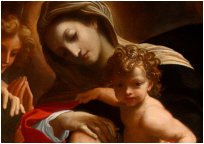St. Colman Builds a Monastery
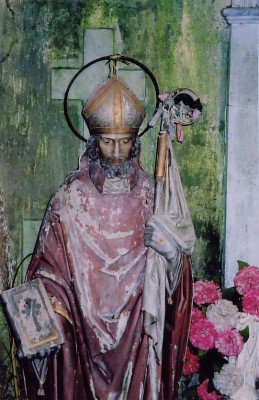
St. Colman Mac Duagh practiced Heroic Virtue |
 he character and virtue of the "Holy Solitary of Burren" were providentially made public. St. Colman's austerities and miracles were on the lips of all. The hospitable King Guarie urgently requested that St. Colman should found a monastery, and also assume episcopal charge of the territory. (The office of abbot and bishop were frequently united at that time in Ireland).
he character and virtue of the "Holy Solitary of Burren" were providentially made public. St. Colman's austerities and miracles were on the lips of all. The hospitable King Guarie urgently requested that St. Colman should found a monastery, and also assume episcopal charge of the territory. (The office of abbot and bishop were frequently united at that time in Ireland).
St. Colman earnestly prayed for Divine guidance, and it was revealed to him that the king's requests were in conformity with the Will of Heaven. It was further revealed that the site of his monastery and cathedral would be miraculously pointed out to him. His girdle (cincture) was to drop to the earth of itself, on the particular place on which the monastery was to be founded.
This miraculous sign took place. As St. Colman journeyed through the forest, his cincture (girdle) fell on a certain place not far from his former cell, and there he built his monastery, which from his name, is commonly called Kilmacduagh (Note: Kil means cell/of Mac Duagh). This girdle continued to be long preserved with religious care by his kinsmen, the O'Shaughnessys. It was in their possession in the thirteenth century; and for centuries later. It was studded with gems, and it possessed the marvelous quality of fitting all who were chaste, though it could not be used by the unchaste no matter how thin they may be!
Kilmacduagh (610 A.D.)
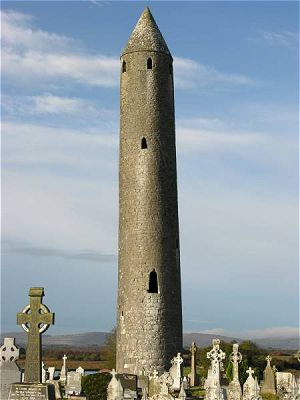
The Tallest Extant Round Tower in all of Ireland is at Kilmacduagh |
St. Colman Mac Duagh thus began a great and holy work that was destined to endure for all time. It was a work which would inscribe his name on the hearts of a grateful Irish people, who would transmit it, with the memory of his virtues, from generation to generation. King Guaire, with his characteristic generosity, not only granted the site for the cathedral and monastery, but also granted large endowments for its future maintenance. His benignity did not stop there. The King through his influence was able to secure the assistance of St. Gobban Saer the eminent architect who flourished early in the seventh century. St. Gobban Saer was an illiterate monk in the monastery of St. Madoc of Ferns. An excerpt from the life of this saint (St. Gobban) provided by an ancient Irish chronicler says,
"A church was to be erected, but no builder could be found to guide the religious brethren in the work. Wherefore, full of confidence in God, St. Aidan (Madoc) blessed the hands of the untutored man named Gobban. From that moment he became most skilled in the intricacies of the art, and was able in a most perfect manner to complete the church of the monastery."
|
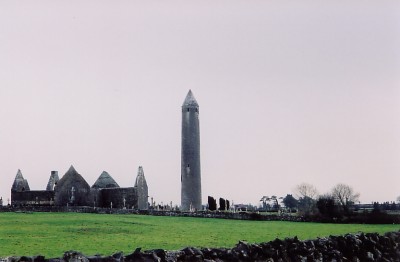
The Monastery of Kilmacduagh, Ireland |
St. Gobban went on to build numerous churches and monasteries throughout Ireland. It was also said of him that it was his constant occupation to do the work of the Saints in every place in which they were, until he lost his sight. There is an ancient prophecy (more than thirteen hundred years old) that says his (St. Gobban's) fame as a builder in wood as well as in stone would last in Ireland to the end of time.
St. Colman Mac Duagh as both the Bishop of the diocese and Abbot of Kilmacduagh, labored solely to enkindle the fire of Divine love in the souls of his spiritual children, and Heaven blessed his labours with the richest fruit. Religious houses flourished around him full of zealous souls. St. Foila's Church, and the monastic establishment of her distinguished brother St. Colga, and also the noteworthy monastery of St. Sourney at Droacoo were under his episcopal charge. In addition there were several other auxiliary houses in connection with the parent house of Kilmacduagh in other districts and diocese throughout Ireland.
The Round Tower
The famous round tower at St. Colman's monastery Kilmacduagh as it stands at present, is one of the most perfect in Ireland. It is also the tallest measuring 110 feet high with a circumference of 56 feet. It leans visibly and has been compared for centuries with the leaning Tower of Pisa in Italy. Round Towers were very important to monasteries and were used as a fortress for the monks themselves and a place to secure their sacred church treasures, i.e., the rich manuscripts, the jeweled croziers, and costly chalices.
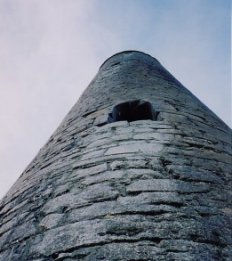
Standing beneath the
110-foot Round Tower at Kilmacduagh |
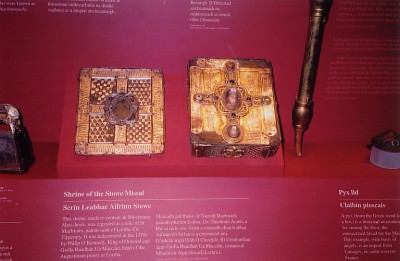
Sacred Church Treasures were formerly kept
in Irish Round Towers |
The History of Ireland shows that Round Towers were essential. For instance it is well remembered that the Northmen (Vikings) poured themselves in droves on the shores of Ireland with the unholy aim of the destroying of the Catholic Faith and taking the sovereignty of the Irish nation itself. The ruined monasteries and plundered churches of the provinces prove this beyond a doubt. In fact various sacred shrines like Armagh and Clonmacnoise were desecrated by pagan rites perpetrated by the idolatrous and barbarous Viking invaders.
Irish Historian Fr. Fahey commenting on the suitability of Round Towers as places of safety for ecclesiastics and their treasures wrote:
"The massive character of the tower at Kilmacduagh, the great height of the door of 26 feet, at which the door is placed, would seem to render it almost impregnable, at a time when the use of artillery was unknown. And though each storey to the top is lighted, the single window in each is placed so near the offsets on which the floors rested, as to show that they were useful for casting out missiles [objects] on assailants as for the admissions of light. It is very noteworthy, that the need of such fortresses continued to be felt even in the fourteenth and fifteenth centuries in Ireland."
A secondary purpose for Irish round towers was that of a bell-house or tower. The Irish designation for the word bell is "clog" and round towers are also called "Clogas." Bells existed in Ireland from the days of St. Patrick. In fact, the bell used by St. Patrick is preserved today in the Irish National Museum in Dublin. These bells were enclosed in costly shrines and the richness of the material, and the delicate detail of the workmanship reflected the reverence their makers had for the sacred. The bells were the most audible when sounded from the top of the "Clogas" (Round Towers) to the ears of the many inhabitants of the monastic buildings that clustered around its base.
The Cathedral (Templemore Mac Duagh)
This is the largest of the many extant monuments at Kilmacduagh. It stands nearest to the round tower. There are some ancient carvings inside the Cathedral. One is of St. Colman Mac Duagh with his Bishops mitre and crozier. The Latin inscription next to it reads, "Sanctus Colomanus Patronus totius Diocesis Duacensis."
(Translation: St. Colman, patron of the entire diocese of Kilmacduagh.)
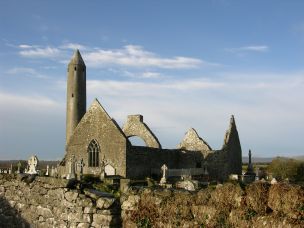
The Cathedral (Templemore Mac Duagh) Kilmacduagh, Ireland |

A view of the inside of the Cathedral at Kilmacduagh |
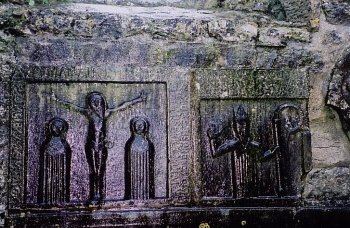
Carvings inside of the Cathedral at Kilmacduagh |
Also, there is a scene of the Crucifixion with the figures of the Blessed Virgin and St. John. Alongside this holy relief are the words in Latin, "Dominus Noster. Sancta Maria. I.N.R.I. Miserere nostri Domine miserere nostri. Fiat misericordia tua domine super nos." (Translation: "Our Lord. Holy Mary. I.N.R.I. Have mercy on us, O Lord, have mercy on us. Let Thy mercy, O Lord be upon us." 1)
The Church of St. John the Baptist (Teampuill Owen)
This Church is close to the Cathedral on the northeast. It consisted of a nave and chancel; but the chancel has entirely disappeared, with the west gable and north side wall. The southern side wall, however, remains; and indicates the length of the nave which was 74 feet long by 22 feet wide.
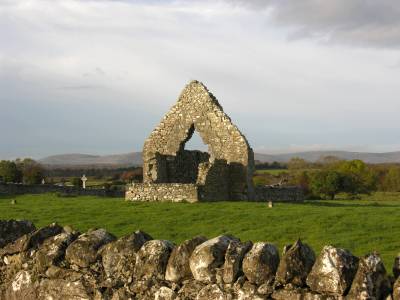
The Church of St. John the Baptist at Kilmacduagh |
The O'Heynes Church or Monastery
This Church has a beautiful chancel arch supported by pillars with animal and floral decoration, and also has two excellently carved east windows.
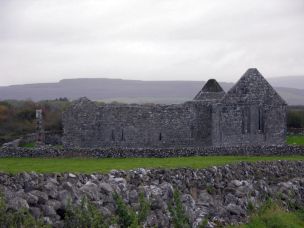
The O'Heynes Church at Kilmacduagh |
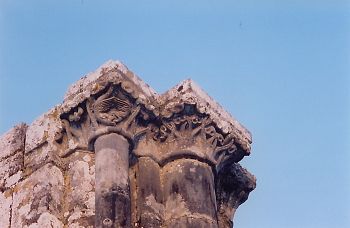
Ornate carvings inside O'Heynes Church Kilmacduagh |
Our Lady's Church (Tempal Muire)
Our Lady's Church is situated at about an equal distance east of the Cathedral. It is separated from the cemetery by the public road. This road was very unfortunately created many years ago through what was part of the cemetery grounds of this holy site. The Church is an oblong building, without a chancel measuring 41 feet 7 inches by 19 feet in breadth. It seems like the sacrilegious plunderers of this Holy Church from years past, had a special interest in dismantling this sacred structure dedicated to the Mother of God. One can only imagine it's original ornateness and beauty.
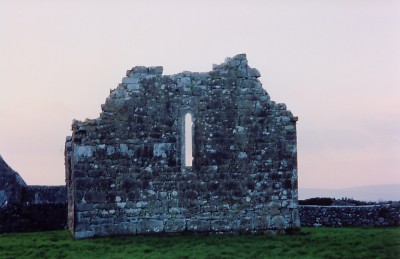
Our Lady's Church at Kilmacduagh Monastic Site |
The Glebe House
It is the common opinion that this was the Abbot of the monastery's living quarters.

The Glebe House (possible Abbot's quarters) at Kilmacduagh |
1 Ps.xxxiii.22.
Next: Back to Burren >>
|
